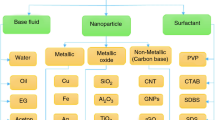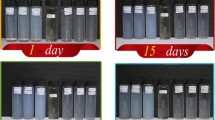Abstract
To able to employ nanofluids in engineering applications, it is essential to investigate heat transfer properties in addition to thermophysical characteristics. In this work, the convection heat transfer coefficient of graphene oxide-distilled water nanofluid along a circular copper tube having a constant heat flux at the outside surface has been investigated both numerically and experimentally under turbulent flow regime. While the nanofluid convection heat transfer and head loss of pressure have been evaluated in the experimental section, the tube wall surface temperature, the convection heat transfer coefficient and friction factor have been obtained by using finite volume method in the numerical part with a three-dimensional domain by assuming single-phase flow. Surface and fluid temperatures and pressure drop of the distilled water have been acquired and compared with the related output from the correlation. Besides, the variations of the tube surface temperatures and the convection heat transfer coefficients of the nanofluids have been examined as numerical and experimental comparisons. The contours of the temperatures, convection heat transfer coefficients and pressure distributions for fluids have been presented. The convection heat transfer performances of the nanofluids according to the different volumetric flow rates, concentrations and the heat flux values have been exhibited in this study. The heat transfer coefficient increment value for the nanofluid of 0.02 vol% concentration and with a flow rate of 1.5 l/min (Re = 5032) has been obtained as about 48% for 5073.244 W/m2 (350 W) heat flux according to the distilled water.
















Similar content being viewed by others
Abbreviations
- A :
-
Area (m2)
- c p :
-
Specific heat (J/kg K)
- D :
-
Tube diameter (m)
- f :
-
Friction factor (–)
- g :
-
Acceleration of gravity (m/s2)
- h :
-
Convection coefficient of heat transfer (W/m2 K)
- h K :
-
Head loss (m)
- I :
-
Current (A)
- k :
-
Thermal conductivity coefficient (W/m K)
- L :
-
Tube length (m)
- \(\dot{m}\) :
-
Mass flow rate (kg/s)
- Nu:
-
Nusselt number (–)
- P :
-
Perimeter of the tube (m)
- Pr:
-
Prandtl number (–)
- \(q^{\prime \prime }\) :
-
Heat flux (W/m2)
- Q :
-
Heat load (W)
- Re:
-
Reynolds number (–)
- T :
-
Temperature (°C)
- V :
-
Voltage (V)
- U :
-
Mean velocity (m/s)
- \(\overline{{U_{i} U_{j} }}\) :
-
Reynolds stress term (m2/s2)
- u :
-
Velocity (m/s)
- x :
-
Distance from inlet of the test section (m)
- ΔP :
-
Pressure drop (Pa)
- µ :
-
Viscosity (kg/m2 s)
- \(\varphi\) :
-
Concentration (%)
- υ :
-
Kinematic viscosity (m2/s)
- α :
-
Thermal diffusivity coefficient (m2/s)
- δ ij :
-
Kronecker delta function (–)
- ε :
-
Energy dissipation rate (m2/s3)
- ρ :
-
Density (kg/m3)
- bf:
-
Base fluid
- c :
-
Cross section
- e :
-
Exterior
- f :
-
Fluid
- i :
-
Interior, inlet
- nf:
-
Nanofluid
- p :
-
Particle
- m :
-
Mean
- m, i :
-
Mean inlet
- s :
-
Surface
- t :
-
Turbulence
References
Maxwell JC (1981) A treatise on electricity and magnetism. Sov Phys Uspekhi 24:904–913
Gupte SK, Advani SG, Huq P (1995) Role of micro-convection due to non-affine motion of particles in a mono-disperse suspension. Int J Heat Mass Transf 38:2945–2958
Kim SJ, Bang IJ, Buongiorno J, Hu LW (2007) Surface wettability change during pool boiling of nanofluids and its effect on critical heat flux. Int J Heat Mass Transf 50:4105–4116
Kwark SM, Kumar R, Moreno G, Yoo J, You SM (2010) Pool boiling characteristics of low concentration nanofluids. Int J Heat Mass Transf 53:972–981
Hong KS, Hong TK, Yang HS (2006) Thermal conductivity of Fe nanofluids depending on the cluster size of nanoparticles. Appl Phys Lett 88:636–664
Hwan L, Hwang K, Janga S, Lee B, Kim J, Choi SUS, Choi C (2008) Effective viscosities and thermal conductivities of aqueous nanofluids containing low volume concentrations of Al2O3 nanoparticles. Int J Heat Mass Transf 51:2651–2656
Xie H, Lee H, Youn W, Choi M (2003) Nanofluids containing multiwalled carbon nanotubes and their enhanced thermal conductivities. J Appl Phys 94:4967–4971
Xie H, Yu W, Li Y (2009) Thermal performance enhancement in nanofluids containing diamond nanoparticles. J Phys D Appl Phys 42:1–5
Singh V, Joung D, Zhai L, Das S, Khondaker S, Seal S (2012) Graphene based materials: past, present and future. Prog Mater Sci 56:1178–1271
Novoselov K, Geim AK, Morozov S, Jiang D, Grigorieva MKI, Dubonos S, Firsov A (2005) Two-dimensional gas of massless dirac fermions in graphene. Nature 438:197–200
Balandin AA, Ghosh S, Bao W, Calizo I, Teweldebrhan D, Miao F, Lau CN (2008) Superior thermal conductivity of single-layer graphene. Nano Lett 8:902–907
Yu W, Xie H, Chen L, Li Y (2010) Enhancement of thermal conductivity of kerosene-based Fe3O4 nanofluids prepared via phase-transfer method. Colloids Surf A 355:109–113
Abreu B, Lamas B, Fonseca A, Martins N, Oliveira MSA (2014) Experimental characterization of convective heat transfer with MWCNT based nanofluids under laminar flow conditions. Heat Mass Transf 50:65–74
Akhavan-Zanjani H, Saffar-Avval M, Mansourkiaei M, Ahadi M, Sharif F (2014) Turbulent convective heat transfer and pressure drop of graphene–water nanofluid flowing inside a horizontal circular tube. J Dispers Sci Technol 35:1230–1240
Akhavan-Zanjani H, Saffar-Avval M, Mansourkiaei M, Sharif F, Ahadi M (2016) Experimental investigation of laminar forced convective heat transfer of graphene water nanofluid inside a circular tube. Int J Therm Sci 100:316–323
Sadeghinezhad E, Togun H, Mehrali M, Nejad PS, Latibari ST, Abdulrazzaq T, Kazi SN, Metselaar HSC (2015) An experimental and numerical investigation of heat transfer enhancement for graphene nanoplatelets nanofluids in turbulent flow conditions. Int J Heat Mass Transf 81:41–51
Ranjbarzadeh R, Karimipour A, Afrand M, Homayoon A, Isfahani M, Shirneshan A (2017) Empirical analysis of heat and friction factor of water/graphene oxide nanofluid flow in turbulent regime through an isothermal pipe. Appl Therm Eng 126:538–547
Karabulut K, Yapıcı K, Buyruk E, Kılınc F (2015) Experimental and numerical investigation of heat transfer enhancement and pressure drop performance of nanofluid containing carbon nanotubes. In: 20th National heat science and technique Congress Balıkesir, Turkey, vol 20, pp 96–105
Anvari AR, Javaherdeh K, Emami-Meibodi M (2019) Investigation of heat transfer and pressure drop of non-Newtonian nanofluid performance through micro channels heat exchanger (MCHE) in cross-flow configuration. J Nanofluids 8:631–639
Khan WA, Haq I, Ali M, Shahzad M, Khan M, Irfan M (2018) Significance of static-moving wedge for unsteady Falkner–Skan forced convective flow of MHD cross fluid. J Braz Soc Mech Sci Eng. https://doi.org/10.1007/s40430-018-1390-3
Khan WA, Sultan F, Ali M, Shahzad M, Khan M, Irfan M (2019) Consequences of activation energy and binary chemical reaction for 3D flow of cross-nanofluid with radiative heat transfer. J Braz Soc Mech Sci Eng. https://doi.org/10.1007/s40430-018-1482-0
Khan WA, Ali M (2019) Recent developments in modeling and simulation of entropy generation for dissipative cross material with quartic autocatalysis. Appl Phys A. https://doi.org/10.1007/s00339-019-2686-6
Shahzad M, Ali M, Sultan F, Khan WA, Hussain Z (2019) Theoretical analysis of cross-nanofluid flow with nonlinear radiation and magnetohydrodynamics. Indian J Phys. https://doi.org/10.1007/s12648-019-01669-3
Ali M, Khan WA, Irfan M, Sultan F, Shahzad M, Khan M (2019) Computational analysis of entropy generation for cross-nanofluid flow. Appl Nanosci. https://doi.org/10.1007/s13204-019-01038-w
Sultan F, Khan WA, Ali M, Shahzad M, Khan F, Waqas M (2019) Slow invariant manifolds and its approximation in a multi-route reaction mechanism: a case study of iodized H2/O mechanism. J Mol Liq. https://doi.org/10.1016/j.molliq.2019.111048
Ahmad S, Tauseef I, Haleem KS, Khan K, Shahzad M, Ali M, Sultan F (2019) Synthesis of silver nanoparticles using leaves of Catharanthus roseus and their antimicrobial activity. Appl Nanosci. https://doi.org/10.1007/s13204-019-01221-z
Kılınc F, Buyruk E, Karabulut K (2020) Experimental investigation of cooling performance with graphene based nano-fluids in a vehicle radiator. Heat Mass Transf 56:521–530
Hajjar Z, Rashidi A, Ghozatloo A (2014) Enhanced thermal conductivities of graphene oxide nanofluids. Int Commun Int Heat Mass Transf 57:128–131
Hummers WS, Offeman RE (1958) Preparation of graphitic oxide. J Am Chem Soc 80:1339
Karabulut K (2015) Heat transfer enhancement in heat exchangers by using nanofluids. Ph.D., Sivas Cumhuriyet University
Ghozatloo A, Rashidi A, Shariaty-Niassar M (2014) Convective heat transfer enhancement of graphene nanofluids in shell and tube heat exchanger. Exp Therm Fluid Sci 53:136–141
Pak BC, Cho YI (1998) Hydrodynamic and heat transfer study of dispersed fluids with submicron metallic oxide particles. Exp Heat Transf 11:151–170
Gnielinski V (1976) New equations for heat transfer in turbulent pipe and channel flow. Int Chem Eng 16:359–368
Taylor JR (1997) An introduction to error analysis: the study of uncertainties in physical measurements. University Science Books, Sausalito
Bianco V, Chiacchio F, Manca O, Nardini S (2009) Numerical investigation of nanofluids forced convection in circular tubes. Appl Therm Eng 29:3632–3642
Ebrahimnia-Bajestan E, Niazmand H, Duangthongsuk W, Wongwises S (2011) Numerical investigation of effective parameters in convective heat transfer of nanofluids flowing under a laminar flow regime. Int J Heat Mass Transf 54:4376–4388
Rea U, McKrell T, Hu LW, Buongiorno J (2009) Laminar convective heat transfer and viscous pressure loss of alumina–water and zirconia–water nanofluids. Int J Heat Mass Transf 52:2042–2048
Escher W, Brunschwiler T, Shalkevich N, Shalkevich A, Burgi T, Michel B, Oulikakos D (2011) On the cooling of electronics with nanofluids. J Heat Transf 133:1–11
Izadi M, Behzadmehr A, Jalali-Vahid D (2009) Numerical study of developing laminar forced convection of a nanofluid in an annulus. Int J Therm Sci 48:2119–2129
ANSYS Inc., ANSYS FLUENT User’s Guide (2003) Fluent, Netherland, Lebanon, ANSYS Press
Acknowledgements
This experimental work has been supported by Sivas Cumhuriyet University Scientific Research Projects Unit (CUBAP) with M-505 Project Number.
Author information
Authors and Affiliations
Corresponding author
Additional information
Technical Editor: Ahmad Arabkoohsar.
Publisher's Note
Springer Nature remains neutral with regard to jurisdictional claims in published maps and institutional affiliations.
This article has been selected for a Topical Issue of this journal on Nanoparticles and Passive-Enhancement Methods in Energy.
Rights and permissions
About this article
Cite this article
Karabulut, K., Buyruk, E. & Kilinc, F. Experimental and numerical investigation of convection heat transfer in a circular copper tube using graphene oxide nanofluid. J Braz. Soc. Mech. Sci. Eng. 42, 230 (2020). https://doi.org/10.1007/s40430-020-02319-0
Received:
Accepted:
Published:
DOI: https://doi.org/10.1007/s40430-020-02319-0




